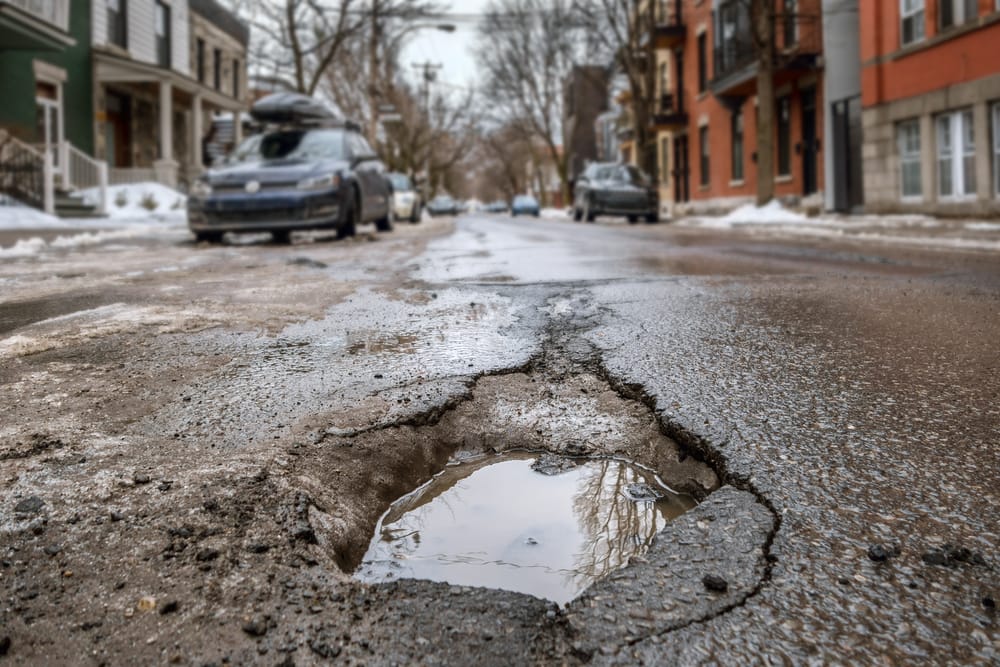Why You Need to Avoid Potholes

Between traffic and construction, roads around Washington, DC, are some of the worst in the nation – at least, according to locals. As we move from Winter into Spring, we enter the part of the year where our roads can really take a beating. The repeated pattern of freezing and thawing temperatures cause cracks and divots in the road from the weather. These problems can get pretty bad before it’s warm enough to repair them as well. Beyond being unsightly and annoying, these potholes can seriously damage your vehicle, up to $300 on average. Don’t believe us? Here's how and why you should avoid potholes.
How Potholes Damage Your car
Bulging or Blown Tires
Since your tires have direct contact with the road and any potholes you might encounter, they’ll bear the brunt of the impact. A common way tires are damaged is by getting pinched in between the rough edge of a pothole and the edge of your tire rim. Even if you don’t see any tears or bulges now, the force can predispose you to a full-blow out later. So, even if your tire is holding air, you’ll want to get it checked professionally and potentially replaced as soon as possible.
Bent or Cracked Rims
If your tires are worn or under inflated, the potential damage to your vehicle is worse. After your tires, your rims will be the ones feeling the impact of a pothole. A forceful hit to the side of a pothole can leave you with a serious dent or break in your tire rims. This sort of damage can make it increasingly difficult to maintain control while driving. This makes you a danger to yourself and others while on the road.
Alignment & Suspension Problems
Your car’s suspension keeps you from feeling every bump and crevice in the road. This leads to a smoother, more enjoyable ride, but also helps you maintain control of your vehicle.
While your shocks and other parts of your car’s suspension system will absorb most impacts, a particularly rough hit can knock it loose. Hard hits like these can leave you vulnerable to every other imperfection on the road. That means a rougher ride, with debris and damaged roads making it harder to maintain control over your vehicle.
Damaged Undercarriage
Depending on how deep the pothole and how low-riding your car is, the bottom of your car can experience issues as well. Deep scratching against the road can lead to any number of issues from loss of power to disconnected fluid lines. Your bumpers and siding may also experience cosmetic damage if it doesn’t get taken off entirely. Damage dealt to the systems in your undercarriage of your car can not only cause you to lose control of your vehicle, but also lead to leaking harmful pollutants into your car’s cabin.
Signs of Pothole Damage
We recommend periodically checking your vehicle for signs of pothole damage during the late Winter and early Spring. Additionally, you should pull over and check for damage as soon as possible after hitting a particularly nasty pothole. Find somewhere safe to pull over and inspect the following areas of your car for:
- Tire wall bulges or punctures
- Bent or cracked tire rims
- Difficulty maintaining your lane
- Difficult controlling your turns
- Unusual vibrations
- Excessive fluid leaks
- Out of place odors
- Cracks in plastic car components
- Front bumper dips when braking
How to Avoid Pothole Damage
With all the ways a pothole can spell trouble for your car, you can see how avoiding them is in your best interest. However, drivers can cause more damage by taking drastic measures to avoid driving over potholes.
If the pothole is in the middle of the road, continue driving as normal. Swerving to avoid a hole in this position just brings your tire in contact with the hole. If moving your car to one side or the other will prevent your tires from hitting the pothole, make sure you are not accidentally swerving into another lane of traffic or into a cyclist.
Sometimes, it’s not possible to avoid a pothole. DC traffic and narrow roads make that common enough. When in this situation, try to safely reduce your speed and release the brakes before rolling over the pothole. Locked up brakes can worsen the impact and damage. Potholes can give your vehicle a jolt, so make sure you have a good grip on your steering wheel to avoid careening in a dangerous direction. Be wary of puddles, as they could be hiding deeper potholes, and remain aware after hitting one pot hole, since it’s common for a few to cluster together.
As we move towards warmer weather, keep an eye out for new or expanding potholes. Hitting large ones with ragged edges can seriously damage your tires, rims, and undercarriage. This damage can be serious enough to cause you to lose control of your vehicle, putting yourself and others in danger. Follow the above tips to avoid pothole damage, and see your local auto technician as soon as possible if you do happen to hit one.
Vehicle care information made available by Metro Motor is presented as helpful advice for general maintenance and should not be construed as instructions for at-home vehicle service. Be sure to consult your owner’s manual and a licensed, professional mechanic for diagnostics and repair.
